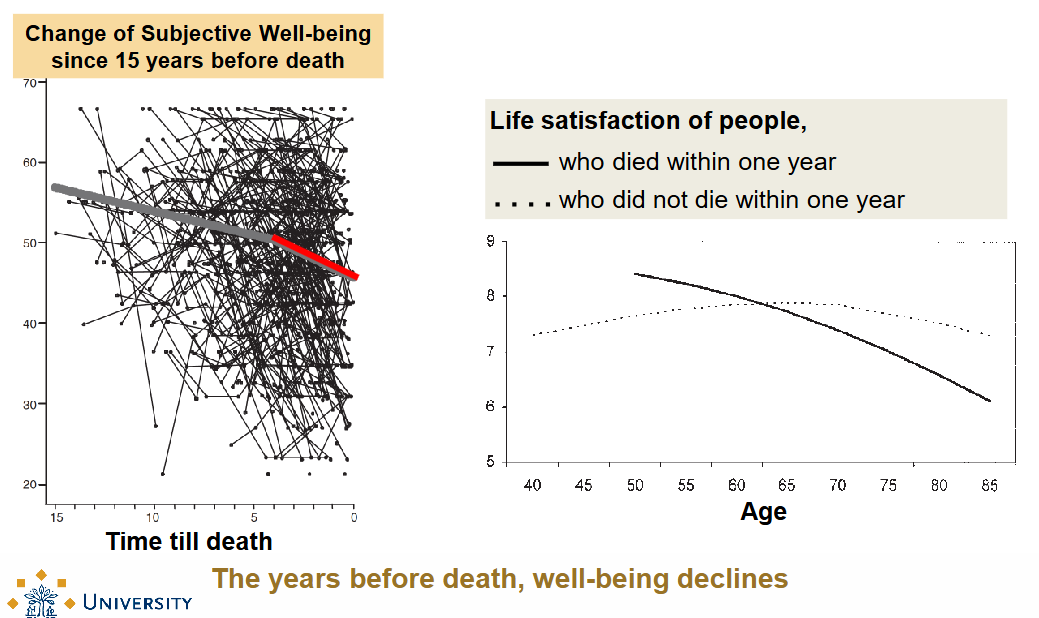Lecture 7 - Emotional development
1/55
There's no tags or description
Looks like no tags are added yet.
Name | Mastery | Learn | Test | Matching | Spaced |
|---|
No study sessions yet.
56 Terms
What is Emotion and what components does Emotions include?
Emotion = Feeling state, often caused by an event.
Components:
Expression (extern)
Physiological arousal (intern)
Subjective evaluation (intern)
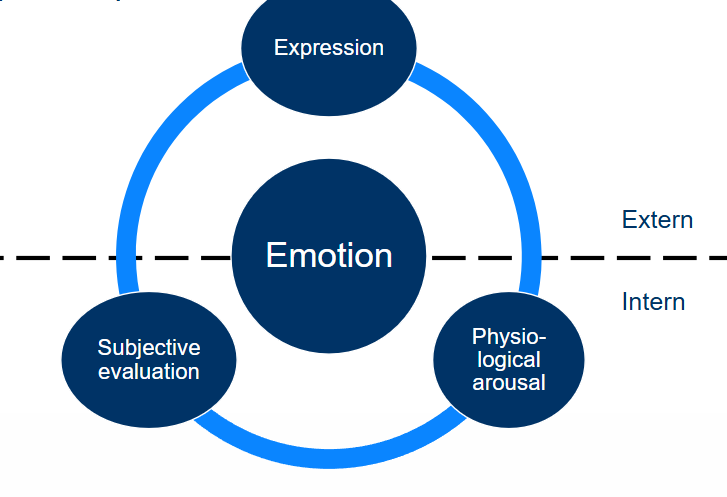
What does Emotion regulation refer to?
To all processes by which we influence which emotions we have, when we have them, and how we experience and express them.
Plays a central role in well-being
Becomes more complex over the lifespan
What components does the Process Model of Emotion Regulation exist of?
Emotion regulation can be applied at different moments:
Situation selection
avoidance
Situation modification
problem solving
situation modification
Attentional deployment
distraction
rumination
Cognitive change
acceptance
reappraisal
Response modulation
suppression
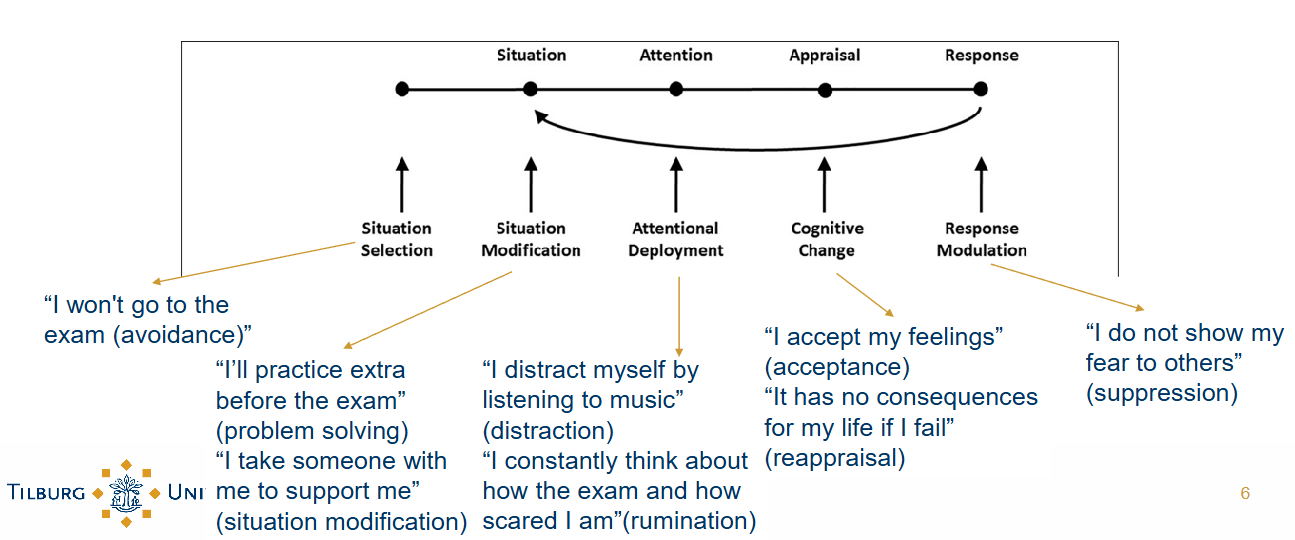
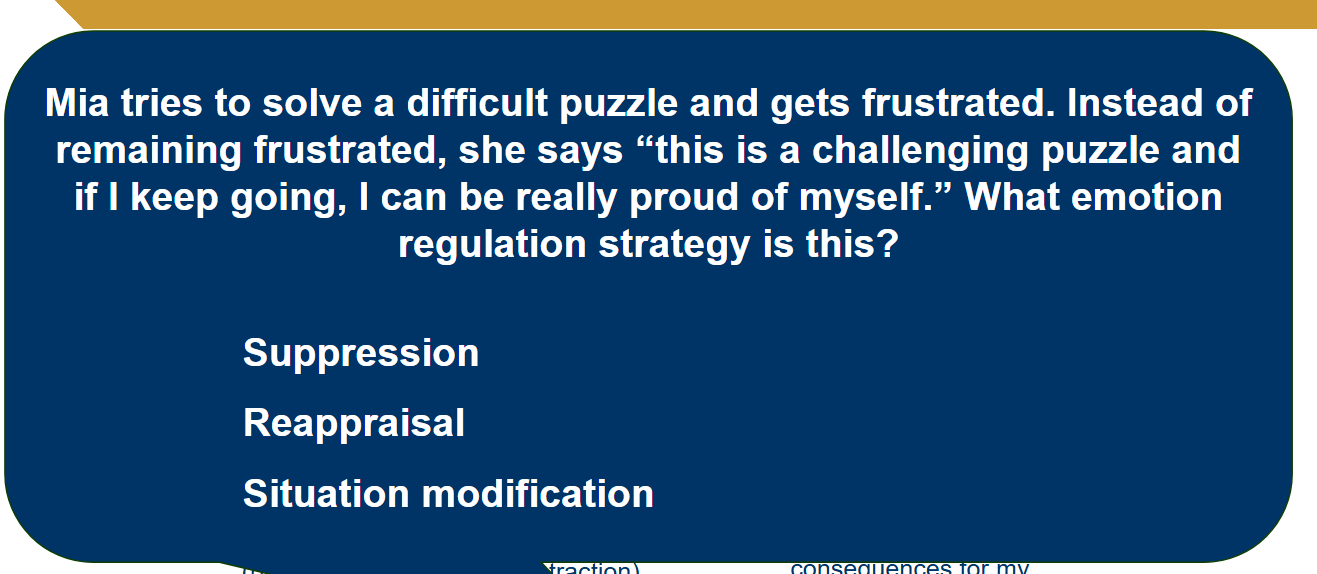
What are 3 Maladaptive and 3 Adaptive strategies?
• But: Sometimes actually useful to suppress feelings →
strategies are not inherently “good” or “bad” (depends on context)
• Current research focuses on emotion regulation flexibility →
dynamically adapting strategies to context

What is emotion regulation flexibility?
dynamically adapting strategies to context.
What does the development of emotions in infants look like?
• Emotions are observable in the first days of life
• Become more complex with age (→ depend on cognitive development)
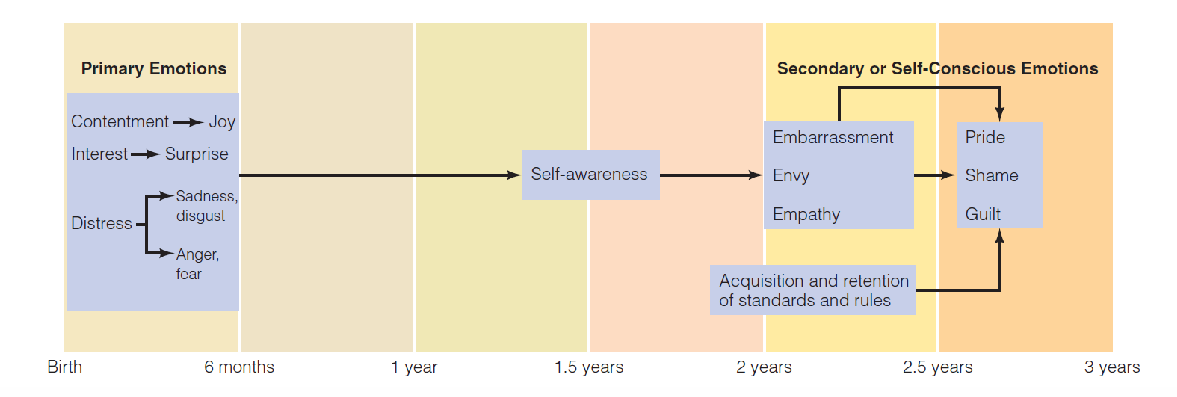
How do we measure emotions in baby’s when they cannot talk?
Observation of facial expression (e.g. by raters).
What are the 7 types of emotions we see in infants?
Joy
Anger
Interest
Disgust
Surprise
Sadness
Fear
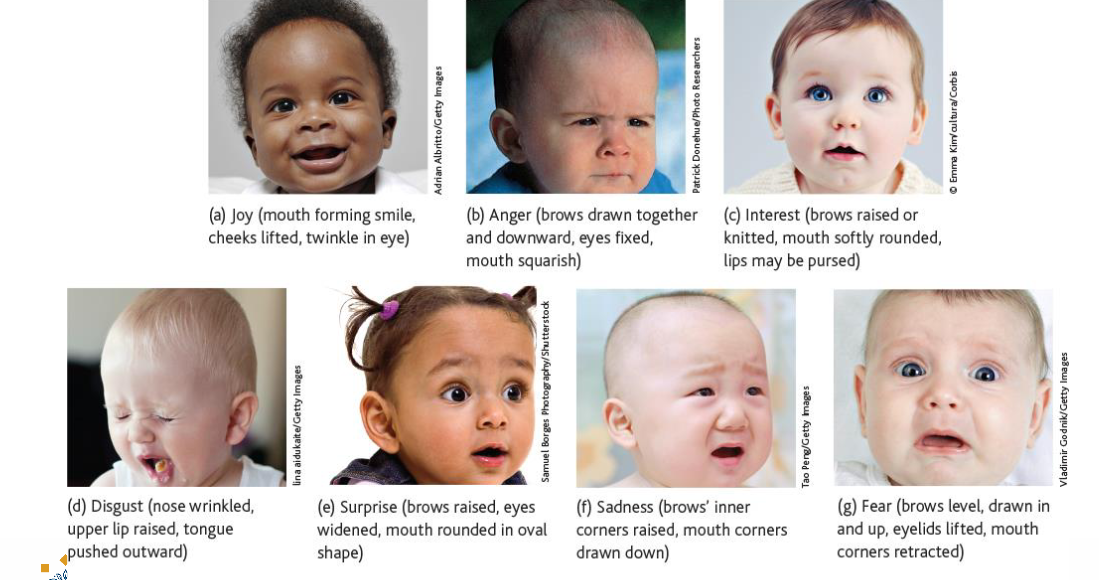
Showing emotions has a biological basis, but there is also environmental influence. What are 2 arguments?
• Children mirror emotional expressions of caregiver
• Mothers respond selectively to their babies’ expressions → learning: infants are trained to show happy faces more often than grumpy or sad ones
→ Early emotion socialization: different shapes in different cultures
Around what age does social referencing develop? What is it?
Around 9 months.
Imitation of parents’ emotions and decision tool for how to behave in new situations.
note: using parent’s expressions of emotions to decide how to act (ex. smiling, is continuing to crawl towards parent; fear, stop crawling).
What is Emotional communication?
Infants and young children learn to understand emotions and express them appropriately.
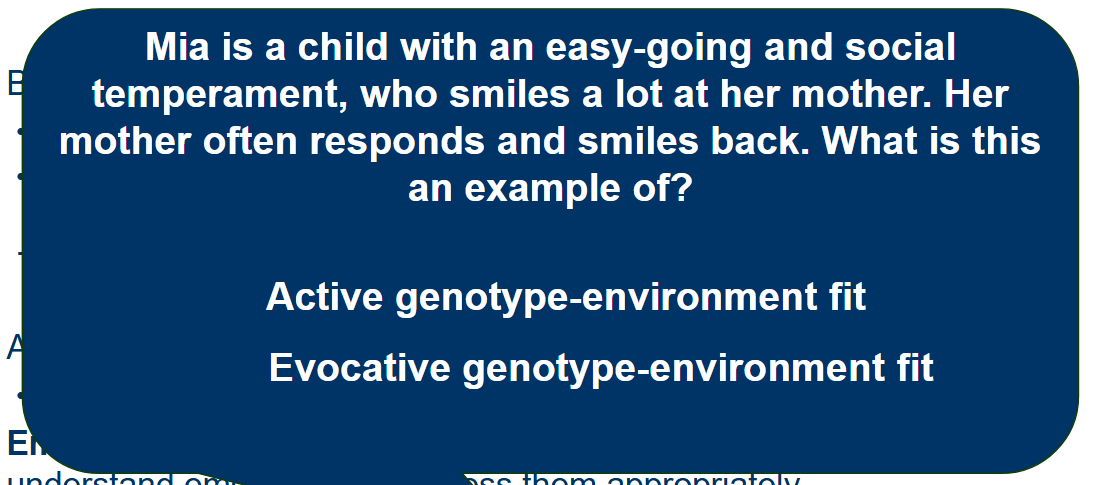
Reminder: Social referencing anxiety
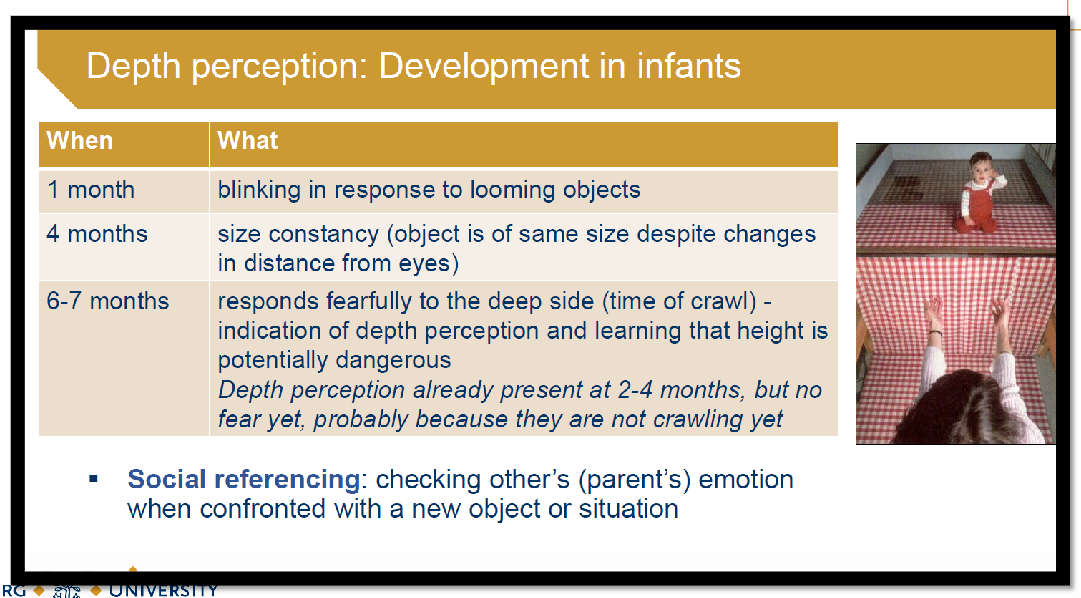
What does the Visual cliff experiment show?
Babies using social referencing: babies use their mother’s expression (happy or afraid) to decide to crawl over the glass floor or not (babies perceive depth).
What does the Still face experiment by Tronick show?
Parents play a crucial role in emotion development.
note: When a parent does not respond to the children’s emotional needs, the child becomes distressed.
Babies regulate their emotions from the start, but use increasingly complex strategies and regulate more independently as they get older.
What Emotion regulation strategies are shown in 0-12 months?
• Some simple strategies (e.g., turning away or sucking on pacifier)
• Seeking support from caregivers
• Some simple strategies (e.g., turning away or sucking on pacifier)
• Seeking support from caregivers
What age is the child demonstrating these emotion regulation strategies?
0-12 months.
Babies regulate their emotions from the start, but use increasingly complex strategies and regulate more independently as they get older.
What Emotion regulation strategies are shown in 18-24 months?
• Try to control whatever is upsetting them (e.g., pushing other kids)
• May be able to cope with frustrations, often by distracting themselves (distraction)
• May knit their brows or compress their lips to suppress their anger or sadness (suppression)
• Try to control whatever is upsetting them (e.g., pushing other kids)
• May be able to cope with frustrations, often by distracting themselves (distraction)
• May knit their brows or compress their lips to suppress their anger or sadness (suppression)
What age is the child demonstrating these emotion regulation strategies?
18-24 months.
Babies regulate their emotions from the start, but use increasingly complex strategies and regulate more independently as they get older.
What Emotion regulation strategies are shown in end of 2nd year?
End of 2nd year = Capacity for symbolic thought and language.
Cognitive regulation of distress (e.g., by repeating
comforting words) → first mainly behavioral (motor), now
also cognitive strategies
Cognitive regulation of distress (e.g., by repeating
comforting words) → first mainly behavioral (motor), now
also cognitive strategies
What age is the child demonstrating these emotion regulation strategies?
End of 2nd year → Capacity for symbolic thought and language.
Babies regulate their emotions from the start, but use increasingly complex strategies and regulate more independently as they get older.
What Emotion regulation strategies are shown in Age 3-4?
Age 3-4 = Development of prefrontal cortex.
Improvements in emotion regulation
Better regulation of negative emotions
What age is the child demonstrating these emotion regulation strategies?
Improvements in emotion regulation
Better regulation of negative emotions
Age 3-4 = Development of prefrontal cortex.
What are 3 abilities that show Further improvement of emotional competence during childhood?
• Concept of mixed emotions
• Mental time-travel: anticipation and recall of cognitive and emotional aspects of events, better understanding of emotions
• Improved ability to suppress or hide negative emotional reactions (e.g., not showing sadness to parents)

What is Mental time-travel?
Anticipation and recall of cognitive and emotional aspects of events, better understanding of emotions.
What are 3 abilities that show More complex use of emotion regulation strategies during childhood?
Use of self-initiated strategies to focus feelings elsewhere
More effective emotion regulation through cognition (e.g., reappraisal)
Development of an ability to experience genuine empathy, truly understanding how another person feels
What is emotional competence an important predictor of?
Social competence.
Why is it important for children to learn rules for emotional behavior (emotional display rules)?
Gap (+ awareness) between inner emotions and expressed emotions widens
Requires understanding of emotions and rules for emotional displays + skills for self-control
What are the cultural differences in emotional display rules?
Individualistic cultures
Preference for self-directed emotions, encouragement for expression.
ex. USA
Collectivistic cultures
Preference for emotions directed at others (e.g. empathy).
ex. Japan
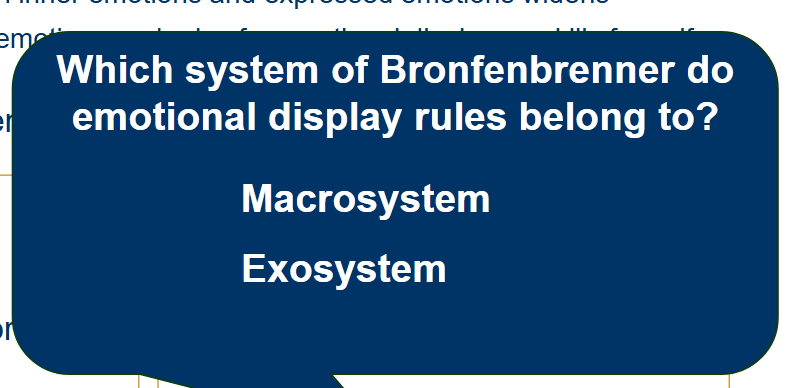
What is Experience sampling method (ESM) for?
Measuring state-level of emotions, cognitions, behaviors in daily life through an app
Experience Sampling Method (ESM):
Multiple times a day
Example: “How happy do you feel right now?”
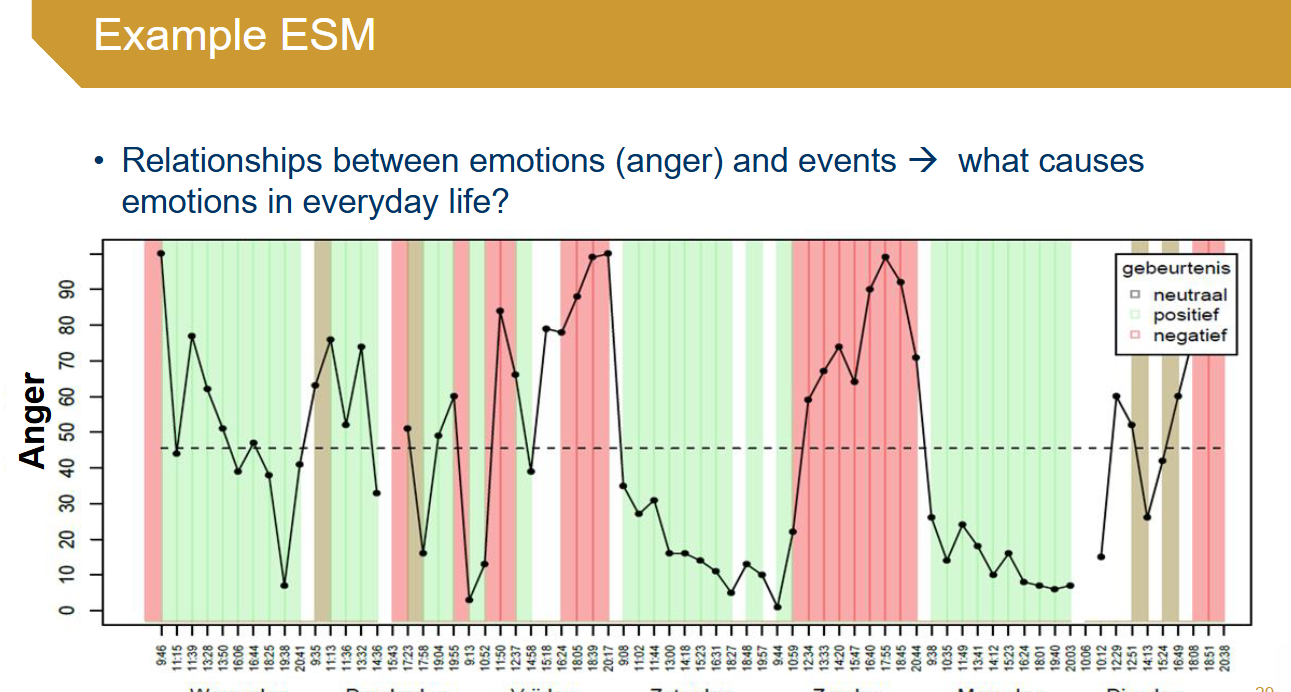
What is a Diary study (“daily diary”)?
Only one questionnaire at the end of the day, over the entire day
• Example: “How happy did you feel today?”
What are the 3 Advantages and 2 Disadvantages of the Research methods we use to measure emotions?
Advantages:
Low recall bias
High ecological validity
Study of short-term dynamics
Disadvantages:
High burden on subjects
Measurement reactivity
What are 2 stereotypes of the Moody teenager?
More negative emotions, less positive emotions (intensity)
More extreme emotions and emotion fluctuations (variability/dynamics)

What does the study of Maciejewski et al. (2017) on Emotion intensity in adolescence reveal?
A decline in positive emotions, stronger decline for girls.
An increase in negative emotions, same development, but girls score higher on average.
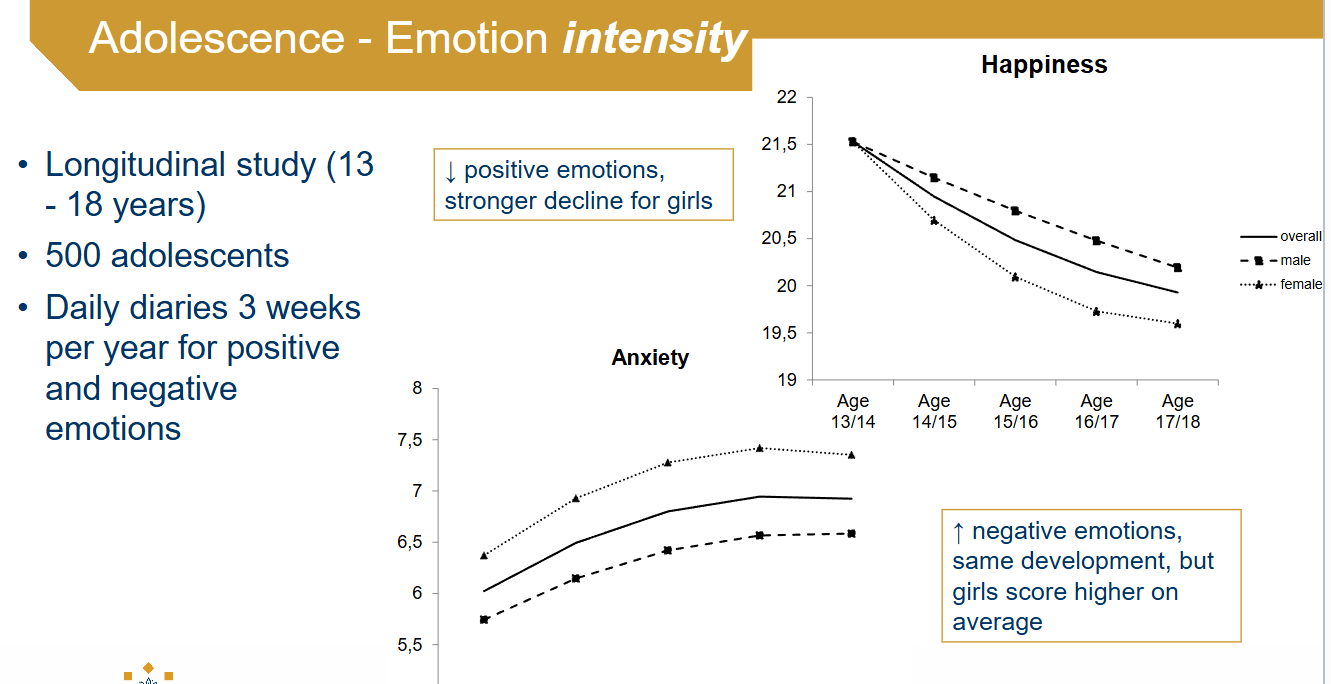
What did research on Emotion variability in adolescents show?
Adolescents show more extreme swings than children and adults.
From euphoria to deep unhappiness.
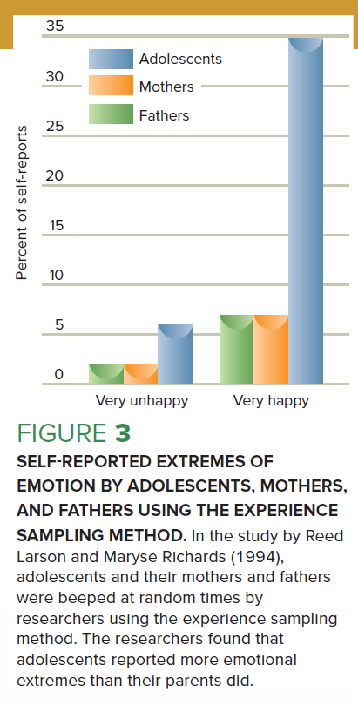
What are 2 explanations for the changes in emotions during adolescence?
Many changes in adolescence (positive and negative; e.g., first romantic relationships, conflicts with parents)
Ineffective emotion regulation (→ executive functions not yet fully developed)
→ Combination leads to more negative and fluctuating emotions
But: variability become less over adolescence → indication that emotion regulation improves.
Adolescents have different emotion regulation goals than adults (goal: e.g., do not avoid conflict)
• Goals:
Broaden horizons
Acquire knowledge
Meet new people
Taking risks
Behavioral set of exploration: Accumulation of information in preparation for a future when these may be necessary.
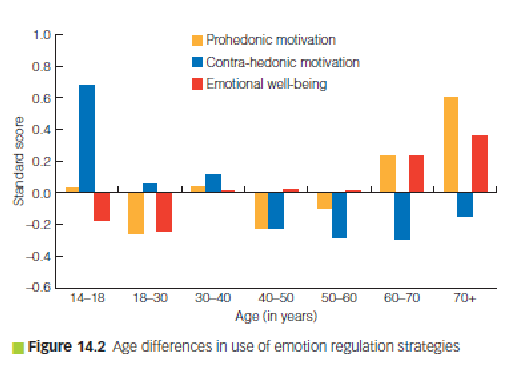
How do developmental changes in emotions continue through the adult years?
• Developmental changes continue through the adult years
• Effort to create lifestyles that are emotionally satisfying, predictable, and manageable
by making decisions about an occupation, a life partner, and other circumstances (where do I want to live, do I want kids)
• “The adaptive integration of emotional experience into satisfying daily life and successful relationships with others”
What happens in Middle adulthood?
Midlife at the intersection of growth and decline.
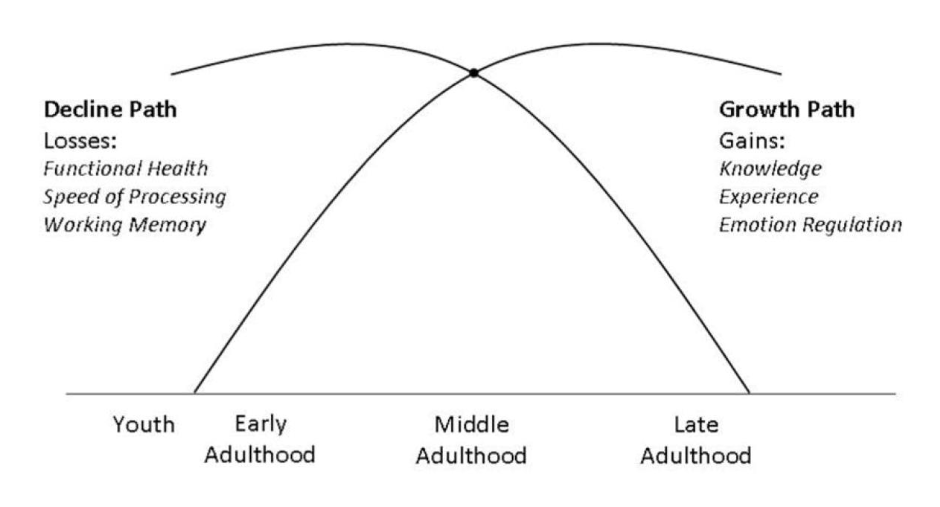
There is a temporary dip in well-being during Midlife; why is that? Name 2 reasons.
Life transitions (e.g., raising kids, losing loved ones) may bring stress and uncertainty
Social comparisons may put pressure on individuals (social clock theory)
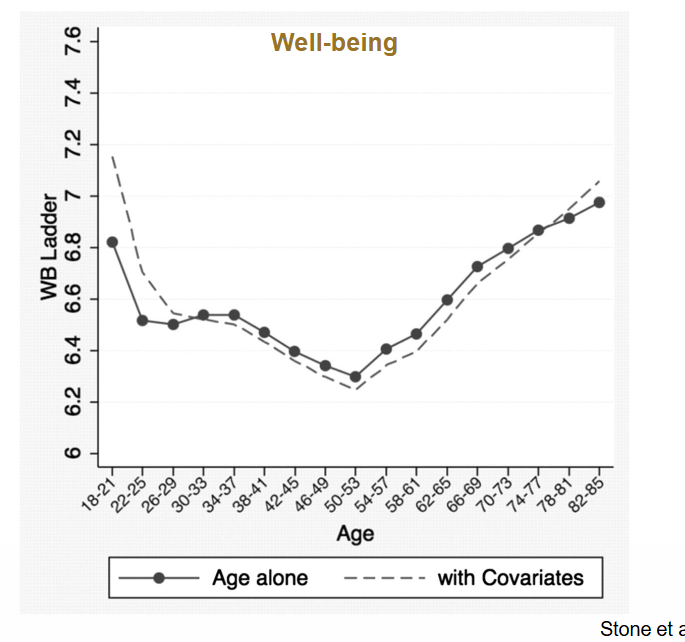
What are 7 challenges in older age?
Declining health and memory
Last opportunities
Confrontation with one’s own mortality
Loss of one’s loved ones
Loss of independence
Loss of purpose, loneliness
Financial penalties
Do older adults experience more negative emotions and reduced well-being as a result of these challenges?
On average, positive emotions remain more stable and negative emotions become less frequent → better balance between positive and negative emotions.
Few changes in happiness
Large decreases in stress
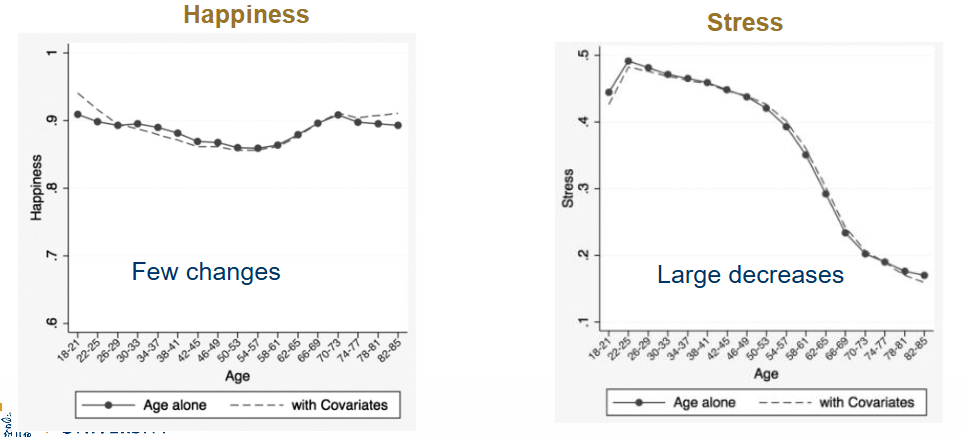
What are some explanations for changes in emotions in older age?
Older adults can detect and feel negative emotions – but they control the amount of time spent focusing on negative emotions
Positivity bias (or negativity avoidance): A form of selective attention: Relatively more attention to, and better memory for, positive compared with negative information.
Brain regions involved in emotions (e.g., amygdala) degenerate less with age than the major brain regions involved in cognition (prefrontal cortex
What is Positivity bias (or negativity avoidance)?
A form of selective attention: Relatively more attention to, and better memory for, positive compared with negative information.
What is the biological (brain) explanation for changes in emotions in older age?
Brain regions involved in emotions (e.g., amygdala) degenerate less with age than the major brain regions involved in cognition (prefrontal cortex).
What was the result of the study on Positivity bias for emotion detection in faces?
Older adults pay less attention to/avoid more negative emotions than younger adults.
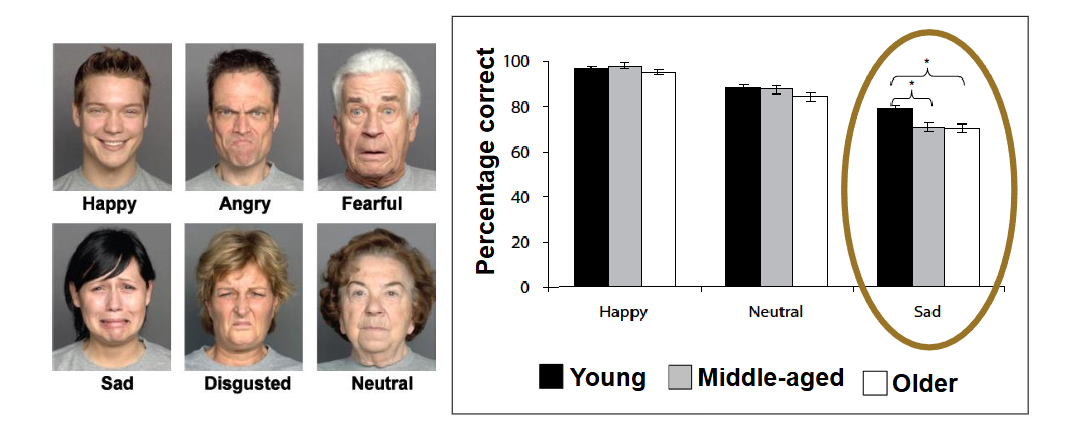
What was the result of the study on Positivity bias and memory?
Older adults recall fewer negative information.
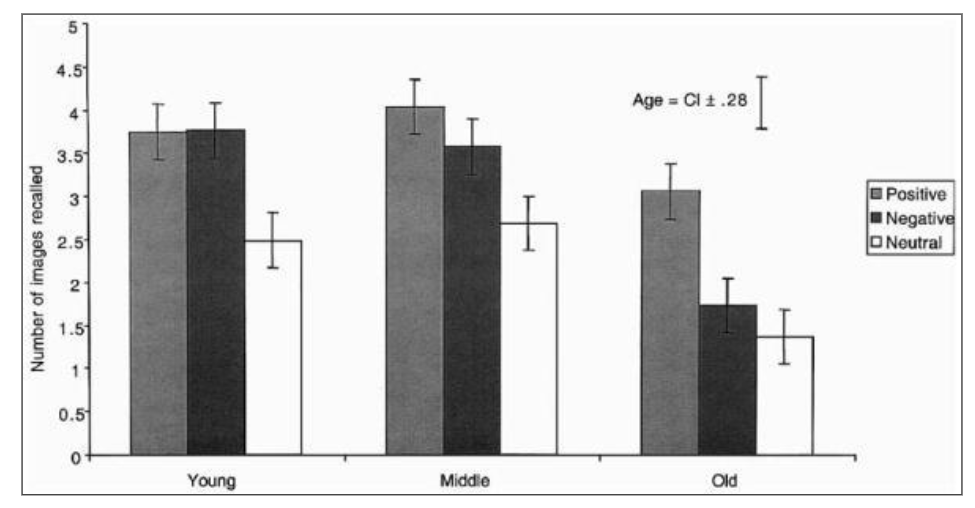
What does the Socioemotional selectivity theory by Carstensen entail?
The approach of endings, due to aging or other (e.g., geographic relocations, severe illness) elicits motivational changes:
Emotionally meaningful goals are prioritized over exploration.
Effects:
Effects on preferences, social networks, and emotional experience.
Positivity effect in cognitive processing of older adults:
Pay more attention to, better remember, and place more priority on positive than on negative information.
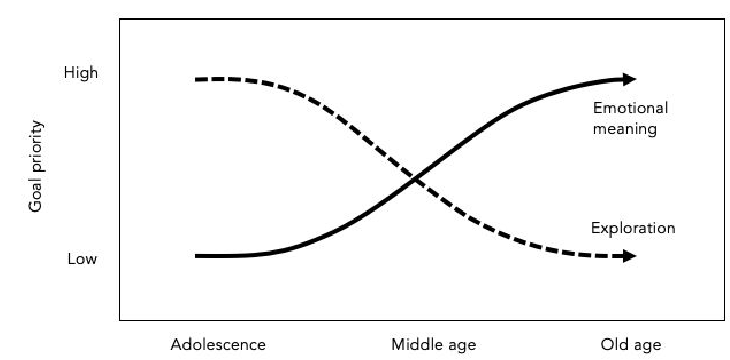
How do emotional choices change during older age?
Time horizons become shorter – goals change: Focus on goals that are realized during the very pursuit of the goal itself: meaning, satisfaction.
Goals:
▪ Live in the moment
▪ Know/see more clearly what’s important
▪ Invest in sure things
▪ Deepen relationships
▪ Savor life
(Clearly different goals than adolescents!)
What do Emotion regulation strategies in older age look like?
More Situation Selection
avoidance of conflict situations
More Situation Modification
older adults de-escalate conflicts more often
More Attentional Deployment
more focus on positive, less on negative stimuli
More Cognitive Change
more acceptance
no difference for reappraisal
Response Modulation — Difference depending om emotion
more suppression for grief

What do Diary studies on emotion regulation in older age show?
Older adults show less variability in their emotion regulation strategies.
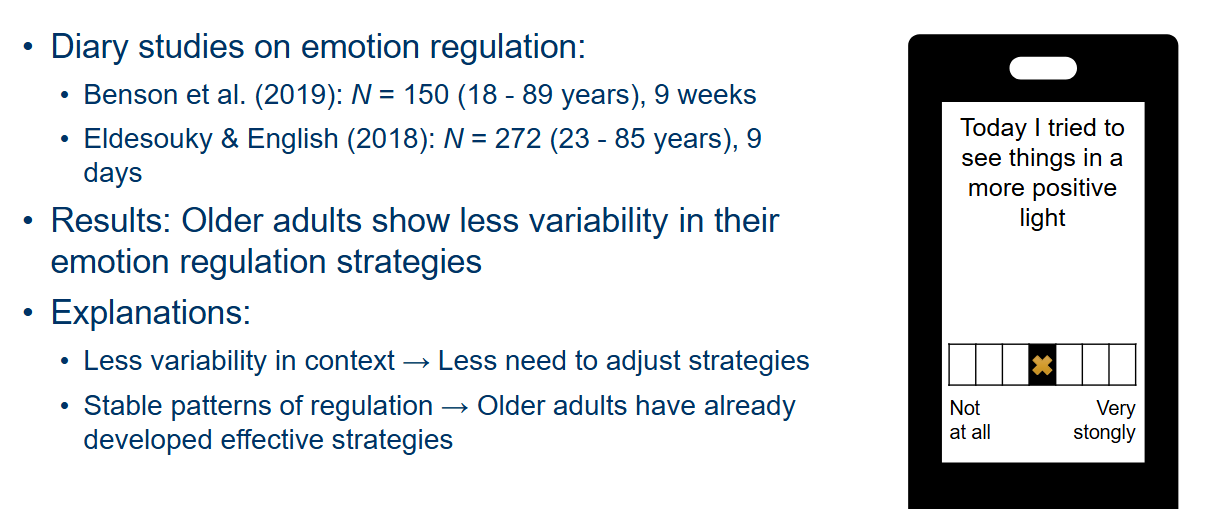
What are 2 explanations on why Older adults show less variability in their emotion regulation strategies?
Less variability in context → Less need to adjust strategies
Stable patterns of regulation → Older adults have already developed effective strategies
What change in Social networks happens during older age?
Selective narrowing of social networks.
Size of inner circle remains the same
Fewer relationships with people of outer circle → if they no longer lead to positive emotions = drop them
Emotional well-being goes up as networks are narrowed
• 10-year sequential design, 3 time-points
• T1: N = 184, 54% female, 18-94 years old
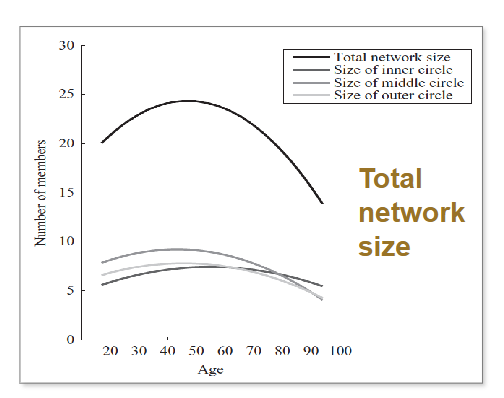
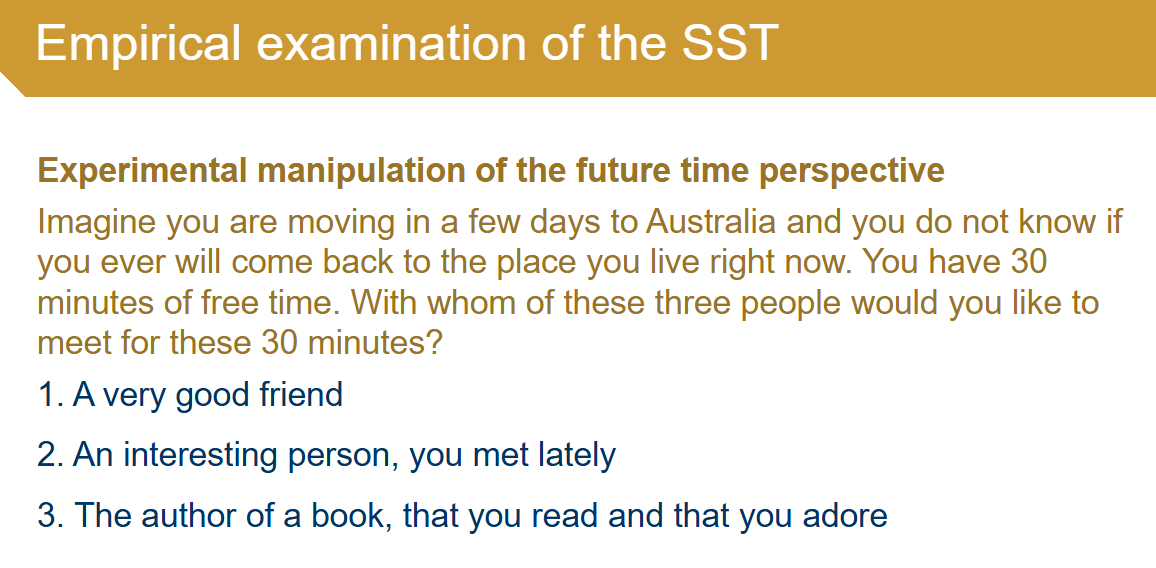
What are the results of this study?
No time limit:
▪ Younger adults pick all three alternatives with the same probability
▪ Older adults more often choose meeting with a close friend
With time limit:
▪ Both age groups pick most often to meet the close friend

What are the limitations for experience of well-being?
The years before death, well-being declines.
